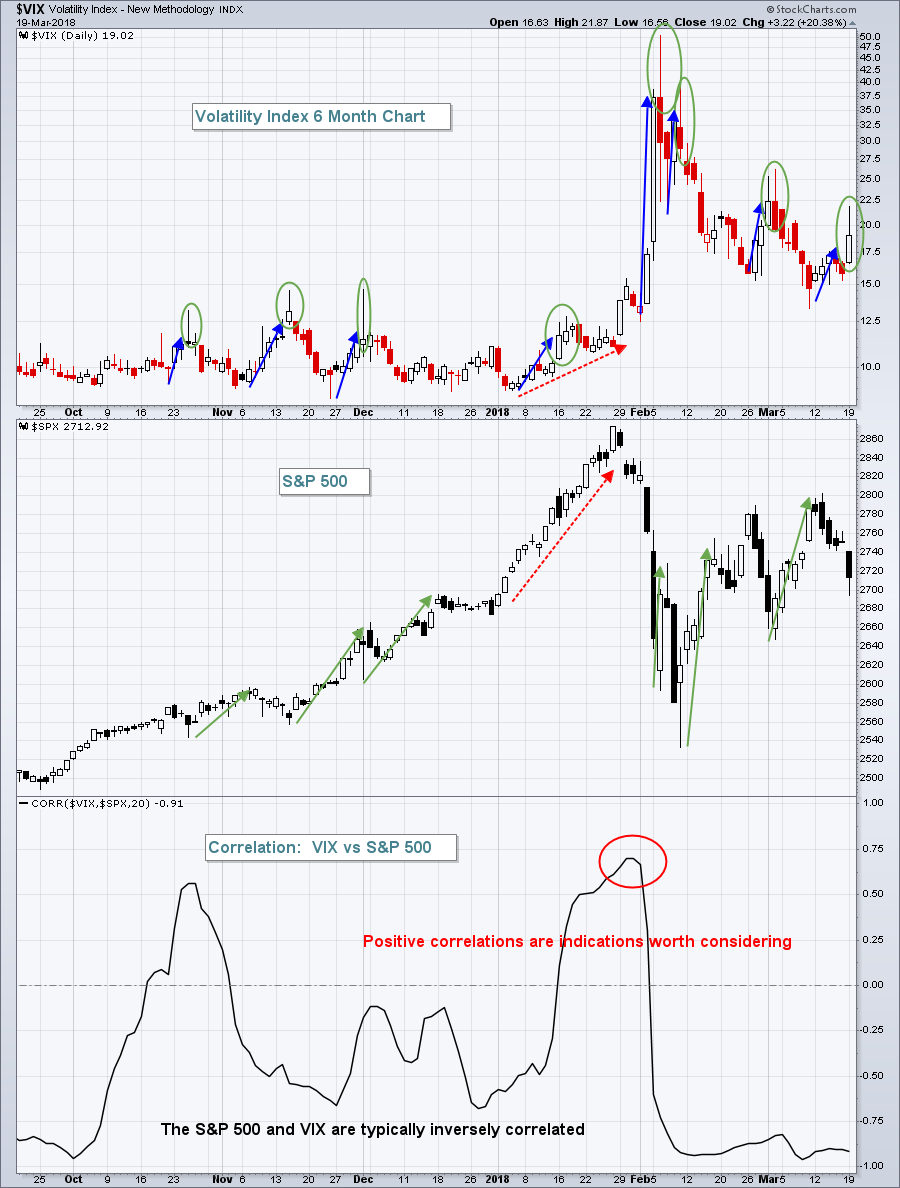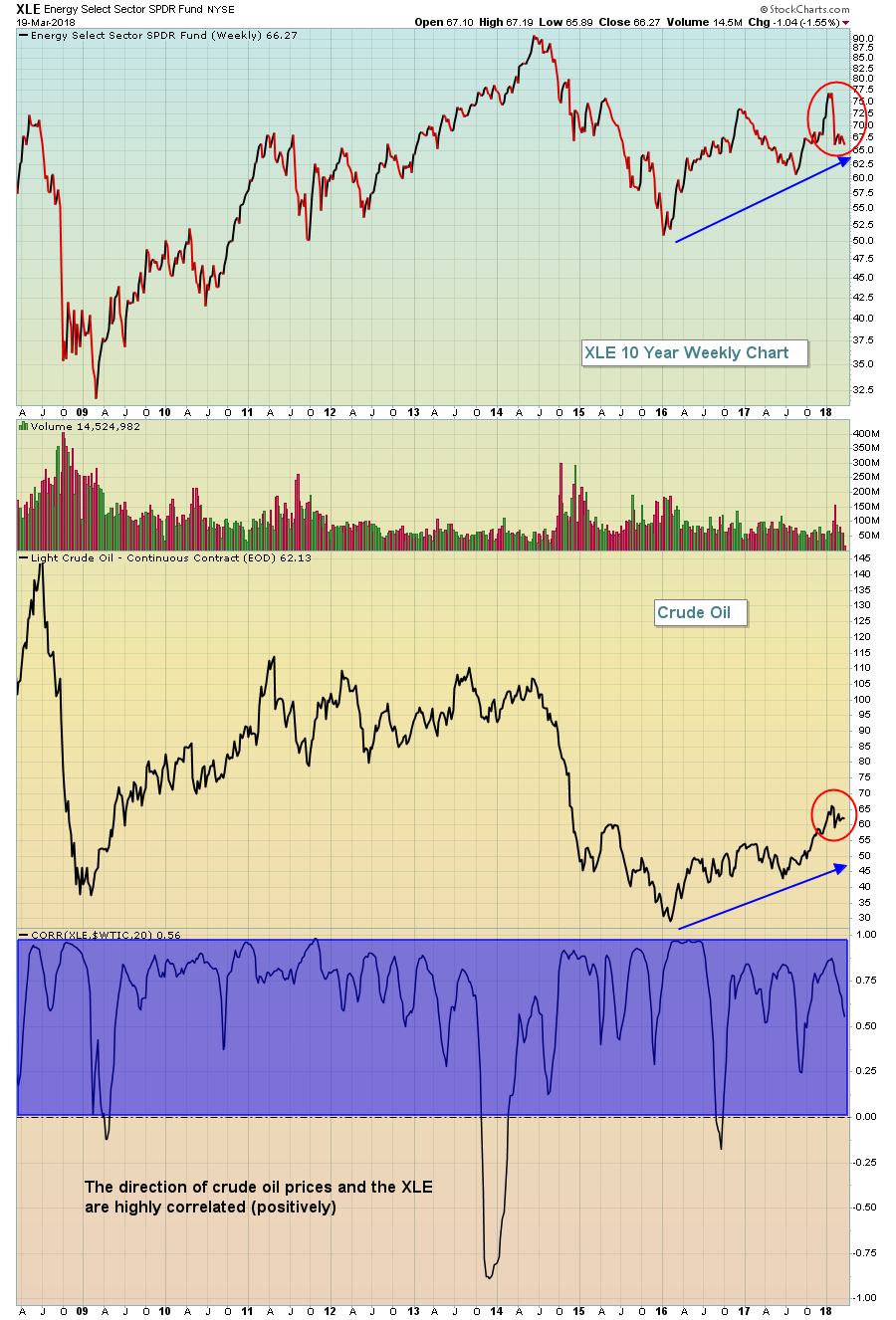Market Recap for Monday, March 19, 2018
Ok, let's start with the obvious. It was an ugly day for U.S. equities. The Dow Jones, S&P 500, NASDAQ and Russell 2000 fell 1.35%, 1.42%, 1.84% and 0.98%, respectively. The Volatility Index ($VIX), which had been declining steadily to its intraday low of 13.31 on Friday, March 9th, suddenly began to surge. The VIX finished 20% higher yesterday, closing at 19.02. While this should have everyone's radar at high alert, there was a silver lining if you're in the bullish camp. The VIX left a "long tail" to the upside on yesterday's candlestick chart. This highlights the fact that volatility expectations died down considerably in late day action and that can be a very strong short-term signal for the S&P 500. Check out this chart:
 Nearly every one of those green circles preceded rallies on the S&P 500. The long tails tell us that the VIX was much higher earlier in that trading session, only to wilt into the close. Lessening fear is typically associated with rising equity prices. The fact that the VIX fell from an intraday high of 21.87 to a close of 19.02 increases the odds of a short-term rally in the S&P 500. I'm talking "odds" here, not a guarantee.
Nearly every one of those green circles preceded rallies on the S&P 500. The long tails tell us that the VIX was much higher earlier in that trading session, only to wilt into the close. Lessening fear is typically associated with rising equity prices. The fact that the VIX fell from an intraday high of 21.87 to a close of 19.02 increases the odds of a short-term rally in the S&P 500. I'm talking "odds" here, not a guarantee.
All nine sectors dropped on Monday, led by a very bearish group of technology stocks (XLK, -1.98%). Despite finishing well off its earlier low, the XLK had one of its worst days since the rapid early February decline and closed beneath its 20 day EMA for the first time in 5 weeks. The XLK has the best SCTR score among all sectors and it'll be interesting to see if yesterday's selling is viewed as a buying opportunity today. Oracle Corporation (ORCL) reported its latest quarterly earnings after the bell on Monday and traders were not impressed. ORCL is down nearly 9% in pre-market trade this morning. Yesterday, however, traders were focused on Facebook (FB). It was reported on Monday that as many as 50 million Facebook users had data breaches when Cambridge Analytica accumulated data from those users without their permission. FB tumbled 6.77%, leading a selloff in the tech-laden NASDAQ, and is threatening a key price support level:
 While FB was notably weak and led to a lot of selling in internet stocks ($DJUSNS), it was mostly an across-the-board type of selloff yesterday. I counted four industry groups (out of more than 100) that seemed to avoid the carnage and post reasonable gains. They were (1) renewable energy ($DWCREE, +2.01%), mortgage finance ($DJUSMF, +1.83%), defense ($DJUSDS, +0.81%) and truckers ($DJUSTK, +0.46%).
While FB was notably weak and led to a lot of selling in internet stocks ($DJUSNS), it was mostly an across-the-board type of selloff yesterday. I counted four industry groups (out of more than 100) that seemed to avoid the carnage and post reasonable gains. They were (1) renewable energy ($DWCREE, +2.01%), mortgage finance ($DJUSMF, +1.83%), defense ($DJUSDS, +0.81%) and truckers ($DJUSTK, +0.46%).
With a falling dollar, gold miners ($DJUSPM, +0.16%) and gold ($GOLD, +0.42%) were also able to post gains and avoid technical breakdowns near intermediate-term price support.
Pre-Market Action
Crude oil ($WTIC) is up 1.6% and it's only a matter of time before rising crude oil prices will result in renewed strength for energy (XLE). Asian markets were mixed overnight while Europe is mostly higher. Dow Jones futures are flat as we head into the open.
Current Outlook
The VIX is elevated and that's always a reason for short-term concern. However, I am sticking to my guns that we are in consolidation mode within an ongoing bull market. Yes, the volatility is nerve-wracking as are the multiple hundred point drops on the Dow Jones. But the underlying signals do not support a bear market at this time. Here are a few relative ratios that I like to follow to determine the "beneath the surface" health of the stock market:
 Yes, the S&P 500 has been struggling, but we recently saw the NASDAQ and NASDAQ 100 (more aggressive indices) break to new highs. The aggressive small cap Russell 2000 threatened a breakout to an all-time high. The ratios reflected above all take aggressive areas of the market and divide them by defensive counterparts. All (except the RUT:SPX which I'll discuss in a moment) were rising when the S&P 500 set its most recent price high. That is an indication that traders continue to sport a "risk on" mentality, a very critical ingredient to sustain a bull market.
Yes, the S&P 500 has been struggling, but we recently saw the NASDAQ and NASDAQ 100 (more aggressive indices) break to new highs. The aggressive small cap Russell 2000 threatened a breakout to an all-time high. The ratios reflected above all take aggressive areas of the market and divide them by defensive counterparts. All (except the RUT:SPX which I'll discuss in a moment) were rising when the S&P 500 set its most recent price high. That is an indication that traders continue to sport a "risk on" mentality, a very critical ingredient to sustain a bull market.
The RUT:SPX has struggled for the past 15 months or so, dealing with a dollar that declined rapidly throughout much of that period. The RUT moved higher, but it simply couldn't keep pace with the S&P 500 as that larger cap index of multinational companies gained the added benefit of a weaker dollar and, in my opinion, that led to the benchmark S&P 500's relative outperformance. Since the dollar bottomed in late-January, you can see that the RUT:SPX has bottomed and begun to rise. I believe the relative fate of small caps vs. the S&P 500 lies mostly with the direction of the dollar.
Sector/Industry Watch
The energy ETF (XLE) has languished quite a bit of late, threatening to break down beneath a key 66 price level. But crude oil ($WTIC), on the other hand, seems to be much more stable and poised for further strength within its two year uptrend. These two - the XLE and WTIC - have a history of being very positively correlated, meaning that they tend to trend together, in the same direction. Look at this chart:
 We're in a bull market and crude oil is rising to reflect increasing global demand, which is exactly what I'd expect. The recent drop in the XLE, however, is reflected in the deterioration of the correlation above. Correlation has been moving lower in 2018 so what gives? Will we see crude oil begin to fall and play "catch up" with the XLE's recent decline? Or will we see the XLE hold support and begin to resume its prior uptrend to play "catch up" with the WTIC's better-looking uptrend? My guess would be the latter, but time will tell.
We're in a bull market and crude oil is rising to reflect increasing global demand, which is exactly what I'd expect. The recent drop in the XLE, however, is reflected in the deterioration of the correlation above. Correlation has been moving lower in 2018 so what gives? Will we see crude oil begin to fall and play "catch up" with the XLE's recent decline? Or will we see the XLE hold support and begin to resume its prior uptrend to play "catch up" with the WTIC's better-looking uptrend? My guess would be the latter, but time will tell.
Historical Tendencies
Two days ago, I indicated I'd breakdown the Russell 2000's performance between 1st half of month and 2nd half of month. As a refresher, here were the breakdowns for the S&P 500 (since 1950) and NASDAQ (since 1971):
S&P 500:
1st through 15th: +11.48%
16th through 31st: +6.08%
NASDAQ:
1st through 15th: +14.23%
16th through 31st: +7.82%
Russell 2000 (since 1987):
1st through 15th: +4.87%
16th through 31st: +15.91%
I find it interesting that small caps (Russell 2000) perform much better during the 2nd half of the month.
Key Earnings Reports
(reports after close, estimate provided):
FDX: 3.08
Key Economic Reports
FOMC meeting begins, with policy statement issued at 2pm EST tomorrow
Happy trading!
Tom






